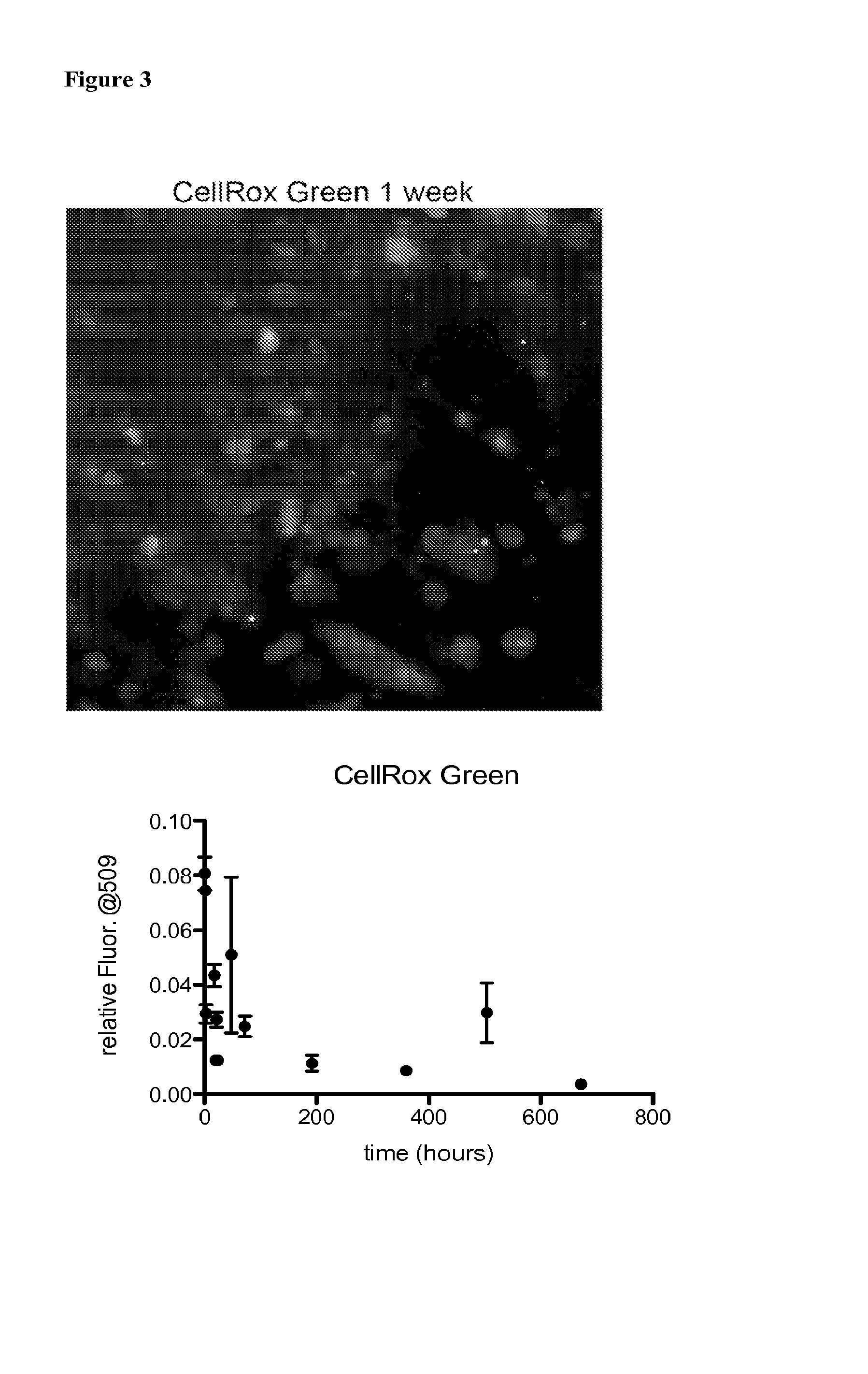Reporter scaffolds
a technology of scaffolds and scaffolds, applied in the field of reporter scaffolds, can solve the problems of limiting subsequent clinical translation, scaffolds have not provided any feedback on the status of cells,
- Summary
- Abstract
- Description
- Claims
- Application Information
AI Technical Summary
Benefits of technology
Problems solved by technology
Method used
Image
Examples
example 1
Fabricating Scaffolds Incorporating Reporter Molecules
[0075]Reporter molecules are encapsulated into a scaffold alone or in pairs (e.g. live / dead pair and the oxidative stress / pH pair), such as in PLGA-based films or synthetic platelets. The encapsulation (or loading) of the reporter molecules will most often occur at the time of fabrication of the scaffold. To measure release of the reporter molecule, the scaffolds are incubated in PBS at 37° C. and the supernatant is collected over time to generate release curves for the reporter molecules.
[0076]The supernatants are administered to 3T3 fibroblasts to determine the bioactivity of the reporter molecules on normal cells and cells under stress. Stress is induced by incubating the cells with different percentages of ethanol prior to incubation with the released reporter molecules.
[0077]Alternatively, the 3T3 fibroblasts are seeded on the scaffolds and the efficacy of the scaffolds in reporting on the cell behavior over time from one to...
example 2
PLGA-Based Film for Treating Atrophic Age-Related Macular Degeneration (AMD)
[0078]Reporter scaffolds based on degradable polymer scaffolds loaded with fluorescent reporter dyes for oxidative stress and intracellular pH as model reporters were generated In vivo, these dyes wash out of cells quickly. By incorporating the dyes directly into the scaffolds, cellular behavior can be observed not just over hours or days but over weeks and potentially months or longer.
[0079]CellROX® Green is a Molecular Probes fluorescent molecule based on fluoroescein that is green upon oxidation by reactive oxygen species (ROS). pHrodo™ Red AM is an intracellular pH Indicator based on rhodamine that is increasingly fluorescent as the pH drops from neutral.
[0080]PLGA 502H films were loaded with the Ce11ROX Green molecule probe or pHrodo Red Am. During fabrication, 4 ml of 10% polymer solution (PLGA 502H in CHC13) was mixed with 50 μl Ce11ROX Green or 4 ul pHRodo Red.
[0081]To investigate release of the repo...
example
3
Incorporation of Reporter Approach into Hemostatic Nanoparticles
[0086]During the fabrication process for the synthetic platelets, fluorophores are added to the system. An example of a procedure for making synthetic platelets that incorporates a fluorophore is below:
[0087]PLGA-PLL-PEG (1 g) is dissolved in anhydrous DMSO to a concentration of 100 mg / ml. Oligopeptides (25 mg GRGDS or GRADSP) is dissolved in 1 ml DMSO and added to the stirring polymer solution. This is reacted for 3 hours, and then transferred to dialysis tubing (SpectraPor 2 kDa MWCO). Dialysis water is changed every half hour for 4 hours with Type I D.I. water. The product is then snap-frozen in liquid nitrogen and lyophilized for 2-5 days.
[0088]The resulting quadblock copolymer PLGA-PLL-PEG-GRGDS (or a blend with PLGA-PLL-PEG) is then dissolved to a concentration of 20 mg / ml in acetonitrile (120 mg / 6 ml). The fluorophore is added to the organic solution. This solution is added dropwise to a stirring volume of PBS. ...
PUM
| Property | Measurement | Unit |
|---|---|---|
| time | aaaaa | aaaaa |
| time | aaaaa | aaaaa |
| time | aaaaa | aaaaa |
Abstract
Description
Claims
Application Information
 Login to View More
Login to View More - R&D
- Intellectual Property
- Life Sciences
- Materials
- Tech Scout
- Unparalleled Data Quality
- Higher Quality Content
- 60% Fewer Hallucinations
Browse by: Latest US Patents, China's latest patents, Technical Efficacy Thesaurus, Application Domain, Technology Topic, Popular Technical Reports.
© 2025 PatSnap. All rights reserved.Legal|Privacy policy|Modern Slavery Act Transparency Statement|Sitemap|About US| Contact US: help@patsnap.com



